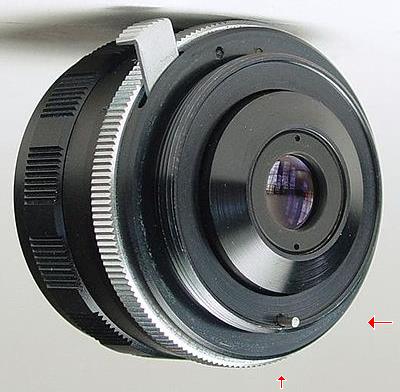
The image above is from Wikimedia Commons, licensed under the Creative Commons Attribution Share-Alike 3.0 Unported License, and is thus available for your use under the same terms.
Its author is Paul M. Provencher.
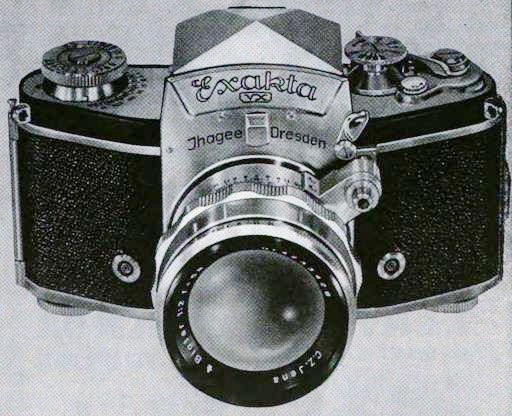
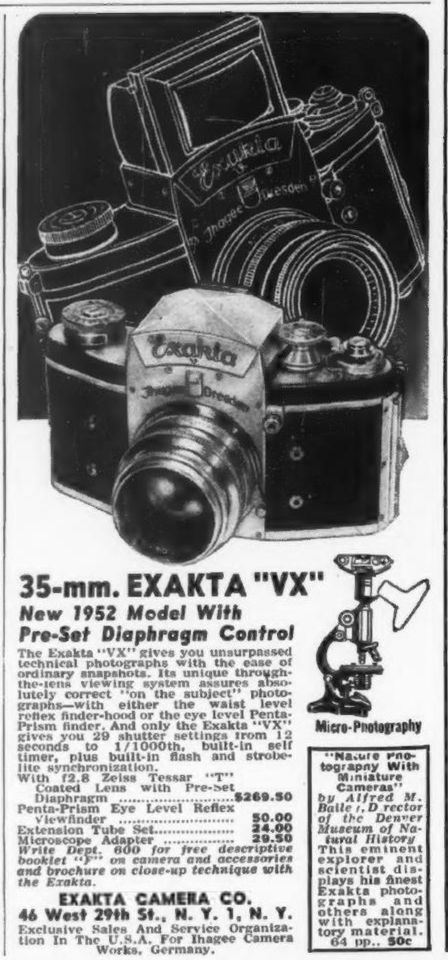
We saw on the previous page that the Exakta Varex, or Exakta V, the first Exakta camera to feature a pentaprism, included it as an optional component which was removable.
This was also true of later cameras from Exakta, such as the Exakta Varex VX (or the Exakta VX in the United States) shown at left, which came out the following year. This allowed a number of special accessories to be used with the camera, and thus there were advertisements for Exakta cameras noting their applicability to taking photographs through a microscope for scientific purposes, an example of which is shown at right.
The Exakta VX has a protrusion extending, on the right of the lens as seen in the photograph, from the top of the lens which is not present in the Exakta VX as pictured in the advertisement on the right.
What it connects to is the shutter release button on the camera body; this extension is a feature of automatic lenses on the Exakta, and similar extensions serving the same purpose were found on lenses for some other types of SLR as well.
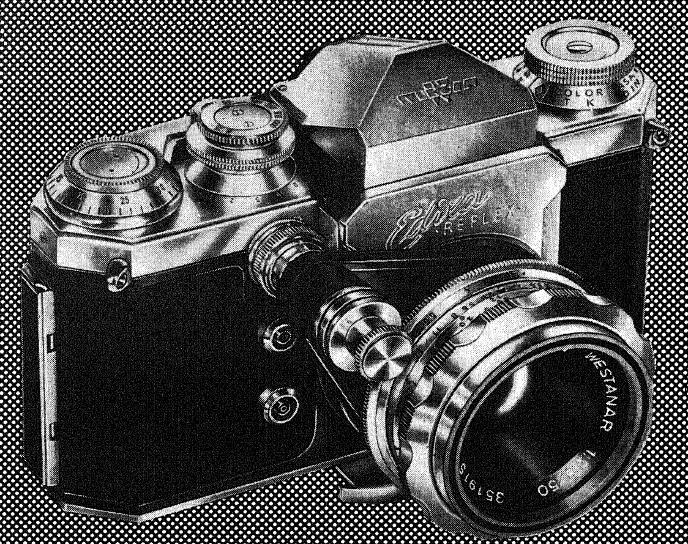
Here is an image of an Edixa Reflex camera, from a multi-page advertisement which reproduces a brochure for the camera, shows an angled extension sticking out from the lens, this time on the left of the photograph.
What it is connecting to is the shutter release button on the camera body.
The very first SLR cameras to use 42 mm screw mount lenses weren't designed to use "automatic" lenses, which only stopped down to the selected aperture when a picture was actually being taken, so that images in the reflex viewfinder could be as bright as possible.
So, since the camera didn't push on a little rod extending slightly from the bottom of the lens to stop the aperture down, as happened on later cameras with screw-mount lenses, some lenses were still made that were automatic by the expedient of having a stop-down button connected to the lens that would also connect to the shutter release button.

This was used on some early Exakta cameras (their lenses, incidentally, were bayonet-mount, not screw mount) as we saw above, and the Start SLR from the Soviet Union, pictured at right, also had this early form of automatic lens.
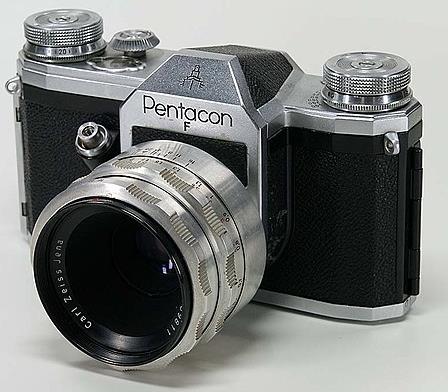
The modern form of the automatic lens, which is much more familiar, had a rounded pin sticking out of what would be the bottom of the lens when it is fully screwed in, which the camera pushed forwards when the shutter was released. This was introduced in 1956 by the Contax F camera, which was termed the Pentacon F for export. This historic camera is shown at left, in an image graciously placed in the public domain on Wikipedia by its author Uwe Möckel.
 |
The image above is from Wikimedia Commons, licensed under the Creative Commons Attribution Share-Alike 3.0 Unported License, and is thus available for your use under the same terms. Its author is Paul M. Provencher. |
At left is an image of a modern automatic lens with the M42 screw mount. I have modified the original image by turning it upside down, cropping it, and adding two arrows, one to the right, and one below, the rod which extends from the back of the lens. This is the pin which, when pushed forwards, causes the iris diaphragm of the lens to move to the aperture set on the lens for the exposure, allowing it to instead remain fully open when the shot is being composed and focused through the viewfinder, and only stop down when the photograph is actually taken.
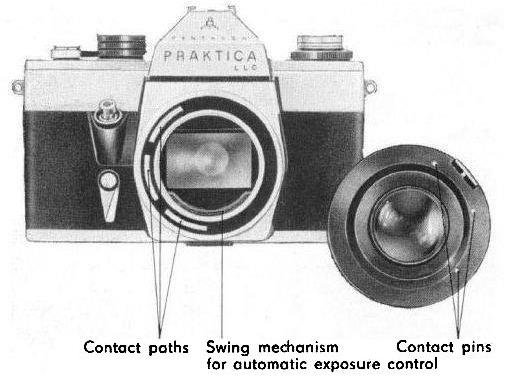
At right is a diagram, from the manual for the Praktica LLC camera, which shows, within the camera body, with the label "Swing mechanism for automatic exposure", the part of the camera which presses on the rod.
Note that this camera modifies the M42 screw mount by also providing for three electrical contacts which interact with lenses designed especially for this camera to take advantage of its advanced features.
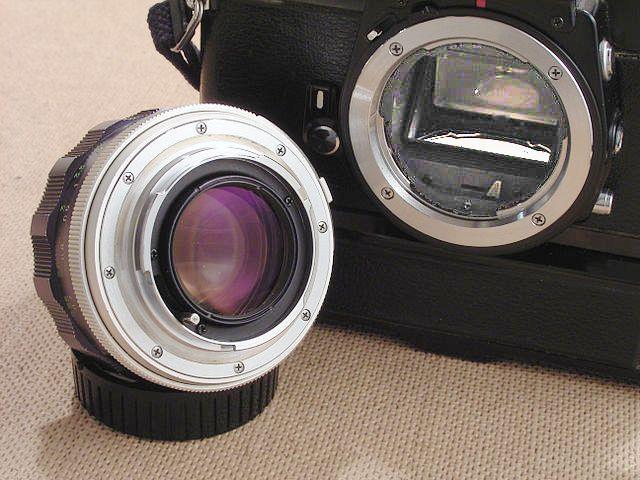 |
The image above is from Wikimedia Commons, licensed under the Creative Commons Attribution-Sharealike 2.0 Germany License, and is thus available for your use under the same terms. Its author is smial. |
As many camera makers shifted from using the M42 screw mount for their cameras to using bayonet mounts, in order to support more advanced automatic exposure features, they often designed the bayonet mounts so that older screw mount lenses could still be easily used with an adapter.
This meant that in many of those mounts, the pin for stopping down the lens remained present, in exactly the same position.
The photograph shown at right is of a Minolta camera lens and body, which use the Minolta SR bayonet mount.
The same is also true, for example, for the Pentax K mount.
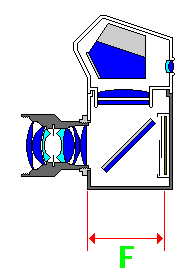
An important consideration when attempting to use, on a given camera, lenses with different lens mounts than the mount for which that camera is designed, through the use of an adapter, is a parameter called the flange-to-film distance.
This is illustrated by the diagram on the left.
The flange plane is where the back of the lens, outside of the actual mount that holds the lens on to the camera, touches the front of the camera.
The film plane is the front surface of the film, on which the image is to be formed by the lens.
And the flange-to-film distance is the separation between those two.
For the M42 screw mount and the Pentax K mount, they are both 45.46 millimetres.
No, this doesn't work out to a round number in inches, despite being such a suspiciously odd number of millimetres. (One and three-quarter inches would be 44.45 millimetres, which nobody has used, despite flange-to-film distances of 44.4 mm and 44.5 mm being used for some types of lens mount. The closest I can come is one and 25/32 inches, which is 45.24375 mm.) But it is almost exactly one and a half bu. (There are 100 bu in a shaku, and a shaku is 100/33 of a metre, and so one and a half bu is 45.454545... or 45 and 45/99 millimetres.) However, since the M42 screw mount was invented in Germany, presumably this is only a coincidence.
On the other hand, the flange-to-film distance for the Minolta SR mount is 43.5 mm, the same as that for the Fujica X-mount.
The Nikon F mount has a large flange-to-film distance of 46.5 mm.
The Miranda cameras had a bayonet mount, but the ring through which the tabs on the lens shaft passed was also threaded. This was so that adapters to allow other types of lenses to be used on the camera would screw on; presumably, if they attached to the camera using its native bayonet mount, then removing such a lens would also tend to remove the adapter at the same time. To allow those cameras to use lenses of other types, their flange to film distance was 41.5 mm, so as to be not greater than that of any other brand of camera.
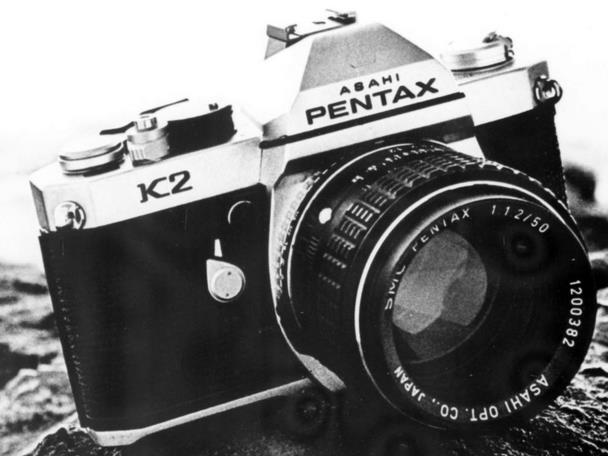
Incidentally, it wasn't until the latter part of 1975 that Pentax introduced the Pentax K mount, having been content until then with the M42 screw mount. The Pentax K2 camera, one of the first batch of K-mount cameras introduced, is shown at right.
A number of countries manufactured 35mm SLR cameras. Germany, Switzerland, Japan, and also Italy and France, as well as the Soviet Union. Upon investigating the matter further, I've found that the People's Republic of China made the Pearl River S-201 35mm SLR camera, the Seagull DF-1 35mm SLR camera, and likely some others as well, and in South Korea, there may have been the Kobica PX-1; it is possible this 35mm SLR with interchangeable lenses was not actually sold despite being advertised at least once, but an earlier model with a fixed lens apparently definitely did exist.
And the German company Leica had the Leica R3 35mm SLR camera bodies manufactured in Portugal, for that matter.
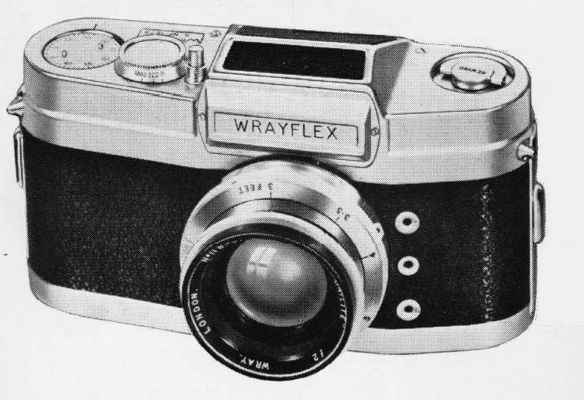
While early medium-format SLR cameras, and a few 35mm rangefinder cameras, were made in the United States, however, apparently no 35mm SLR was ever manufactured in the United States. But three models of one 35mm SLR were manufactured in Britain for a short time, beginning in 1951. This camera was the Wrayflex. The first two models, the Wrayflex I and the Wrayflex Ia, used mirrors rather than a pentaprism, and had a slim appearance. Instead of achieving this the way the French Focaflex did, apparently they did so by reducing the number of reflecting surfaces, so the image was reversed from right-to-left, as it would be in a waist-level finder.
The original Wrayflex I was unusual in another way; its image format was 24mm by 32mm, rather than 24mm by 36mm. So apparently it used seven perforations per image. This was changed in 1953 in the Wrayflex IIa, which was the model of this camera produced in the largest numbers (although it is still extremely rare). It is this version of the camera which is pictured at right.
The Wrayflex II, on the other hand, was completely conventional, in that it had a pentaprism, in addition to following the Wrayflex Ia in using the standard image format. Very few of this camera were made, as it began to be available in 1959, by which time Britain had lifted its post-war exchange controls.
A limited selection of lenses were available for these cameras, as they had a unique proprietary lens mount of their own.
In the more distant past, there were a number of SLR cameras using 120 roll film that were made in Britain; but contemporary with the Wrayflex, and made for the same reason as it, was the Corfield 66. Another postwar medium-format SLR was the Agiflex, which will be mentioned later.